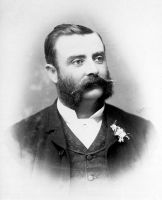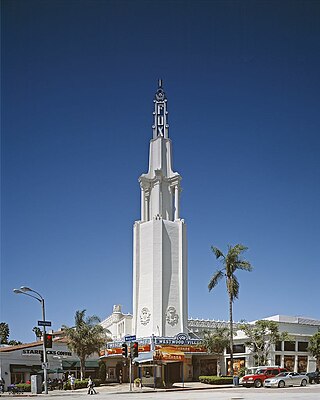
Massey Hall is a performing arts theatre in Toronto, Ontario, Canada. Opened in 1894, it is known for its outstanding acoustics and was the long-time hall of the Toronto Symphony Orchestra. An intimate theatre, it was originally designed to seat 3,500 patrons, but after extensive renovations in the 1940s, it now seats only up to 2,765. It has an extensive history of concerts by artists of many musical genres which continues today.

William Pitt was an Australian architect and politician. Pitt is best known as one of the outstanding architects of the "boom" era of the 1880s in Melbourne, designing some of the city's most elaborate High Victorian commercial buildings. He worked in a range of styles including Gothic Revival, Italianate, French Second Empire, and his own inventive eclectic compositions. He had a notable second career after the crash of the 1890s, becoming a specialist in theatres and industrial buildings.

Metro INOX Cinemas is an Art Deco Heritage grade IIA multiplex Movie theatre in Mumbai, India built in 1938. It was built and originally run by Metro-Goldwyn-Mayer (MGM). The main architect of the cinema was Thomas W. Lamb of New York City, and D. W. Ditchburn of Mumbai was the associate architect. It was one of the main sites targeted in the 2008 Mumbai attacks.

The Pellissier Building and adjoining Wiltern Theatre is a 12-story, 155-foot (47 m) Art Deco landmark at the corner of Wilshire Boulevard and Western Avenue in Los Angeles, California. The entire complex is commonly referred to as the Wiltern Center. Clad in a blue-green glazed architectural terra-cotta tile and situated diagonal to the street corner, the complex is considered one of the finest examples of Art Deco architecture in the United States. The Wiltern building is owned privately, and the Wiltern Theatre is operated by Live Nation's Los Angeles division.

The Octagon is the city centre of Dunedin, in the South Island of New Zealand. It is an eight-sided plaza with a circular one-way carriageway, bisected by the city's main street, and is also the central terminus of two other main thoroughfares. The Octagon is predominantly a pedestrian reserve, with grass and paved features, and is surmounted by a statue of the Scottish poet Robert Burns. Several of Dunedin's significant buildings and institutions adjoin the plaza, which is also a major hub for public transport in Dunedin, primarily taxi services.

Princes Street is a major street in Dunedin, the second largest city in the South Island of New Zealand. It runs south-southwest for two kilometres from The Octagon in the city centre to the Oval sports ground, close to the city's Southern Cemetery. North of The Octagon, George Street continues the line of Princes Street north-northeast for two and a half kilometres. Princes Street is straight but undulating, skirting the edge of the City Rise to its northwest. The part of the street immediately below The Octagon is the steepest section, as the road traverses an old cutting through Bell Hill.

The Capitol is an historic Australian theatre on Swanston Street in the central business district (CBD) of Melbourne, Victoria. Opened in 1924 as part of the Capitol House building, the art deco theatre was designed by American husband and wife architects Walter Burley Griffin and Marion Mahony Griffin. It is the oldest of Melbourne's large picture palaces and is known for its extravagant decor and abstract motifs, including an intricate geometric ceiling containing thousands of coloured lamps designed to evoke the walls of a crystalline cave.

Moray Place is an octagonal street which surrounds the city centre of Dunedin, Otago, New Zealand. The street is intersected by Stuart Street, Princes Street and George Street. Like many streets in Dunedin, it is named for a street in the Scottish capital Edinburgh.

The Capitol Theatre is located in Port Hope, Ontario, and is one of the last fully restored atmospheric movie theatres still in operation in Canada. Now a National Historic Site and still used for performances, it was constructed in 1930, with an interior designed to resemble a walled medieval courtyard surrounded by a forest. It was one of the first cinemas in the country built expressly for talking pictures. It opened on Friday, August 15, 1930, screening Queen High starring Charlie Ruggles and Ginger Rogers.

Stuart Street is one of the main streets of Dunedin, New Zealand. As with many of Dunedin's streets, it is named after a main street in Edinburgh, Scotland.

TheCivic Theatre is a large heritage combination performing-arts theatre, live-music venue, and cinema seating 2,378 people in Auckland, New Zealand. First opened on 20 December 1929, it underwent a major renovation and two-year conservation effort in the late 1990s, and was reopened on 20 December 1999. It is a famous example of the atmospheric theatre style wherein lighting and interior design create the illusion of an open sky complete with twinkling stars, giving the audience the impression of being seated in an outdoor auditorium at night. The Civic is managed by Auckland Live, a business unit of Auckland Unlimited.

An atmospheric theatre is a type of movie palace design which was popular in the late 1920s. Atmospheric theatres were designed and decorated to evoke the feeling of a particular time and place for patrons, through the use of projectors, architectural elements and ornamentation that evoked a sense of being outdoors. This was intended to make the patron a more active participant in the setting.

The State Theatre is a heritage-listed theatre, located at 47-51 Market Street, in the Sydney central business district in the City of Sydney local government area of New South Wales, Australia. The theatre was designed by Henry Eli White with assistance from John Eberson and built between 1926 and 1929. It hosts film screenings, live theatre and musical performances, and since 1974 it has been the home of the annual Sydney Film Festival. It is also known as State Building and Wurlitzer Organ. The property is privately owned. It was added to the New South Wales State Heritage Register on 2 April 1999.

The Regency Village Theatre is a historic, landmark cinema in Westwood, Los Angeles, California. Westwood Village, in the heart of Westwood, is near the University of California, Los Angeles (UCLA). It is currently operated by the Regency Theaters chain. The Westwood Village Theatre has been the site for many Hollywood movie premieres in Los Angeles. The seating capacity of the cinema is about 1,400.

The Gus J. Solomon United States Courthouse is a federal courthouse located in downtown Portland, Oregon, United States. Completed in 1933, it previously housed the United States District Court for the District of Oregon until the Mark O. Hatfield United States Courthouse opened in 1997. The Renaissance Revival courthouse currently is used by commercial tenants and formerly housed a U.S. Postal Service branch. In 1979, the building was added to the National Register of Historic Places as U.S. Courthouse.

The Dunedin Town Hall, also known as the Dunedin Centre, is a municipal building in the city of Dunedin in New Zealand. It is located in the heart of the city extending from The Octagon, the central plaza, to Moray Place through a whole city block. It is the seat of the Dunedin City Council, providing its formal meeting chamber, as well as a large auditorium and a conference centre. The oldest part of the building has been called the only substantial Victorian town hall still in existence in New Zealand.

The Mississippi Lofts and Adler Theatre is an apartment building and theater complex located in downtown Davenport, Iowa, United States. It is individually listed on the National Register of Historic Places by its original name, the Hotel Mississippi and RKO Orpheum Theater. The Hotel Mississippi was listed on the Davenport Register of Historic Properties in 2005. In 2020 the complex was included as a contributing property in the Davenport Downtown Commercial Historic District.

The former Plaza Theatre is located at 650–658 Hay Street, Perth, Western Australia. It was the first purpose-designed Art Deco cinema in Perth. The Plaza Theatre opened in 1937 and was built for Hoyts Theatres Ltd.

Rivoli Cinemas is an eight-screen multiplex in the Hawthorn East suburb of Melbourne. Noted for its Art Deco architecture, the cinema was first built in 1940, and reopened as a multiplex in 2000 following a renovation and expansion.

Henry Eli White, also known as Harry White, was a New Zealand-born architect best known for the many theatres and cinemas he designed in New Zealand and Australia in the 1910s and 1920s. Many of the major surviving historic venues in the two countries are White designs, including the St. James Theatre, Wellington, St. James Theatre, Auckland, the Capitol Theatre and State Theatre in Sydney, and the Palais Theatre and the interiors of the Princess Theatre and Athenaeum Theatre in Melbourne. He also designed the City Hall and the attached Civic Theatre in Newcastle, New South Wales.



















